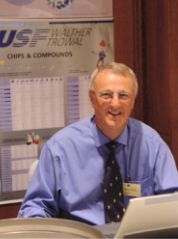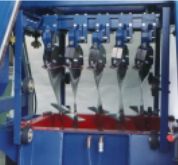E-Archive
Articles
in Vol. 3 - August Issue - Year 2002
The Application of Mass Finishing Systems in the Aircraft Industry

Author Rolf J. Picard, International Sales Manager and Process Consultant


The fields of application for surface finishing in the aircraft industry are widespread. They require high-tech, tailor-made engineering solutions as well as suitable process technologies. Above all, they require extensive experience in the field of mass finishing. Walther Trowal with a tradition in surface finishing of more than 70 years is well qualified to provide these benefits and serve the aircraft industry with innovative finishing solutions for manufacturing and refurbishing of high quality components made of various materials.
Walther Trowal, since being founded in 1931 has been a pioneer in the development of metal finishing technologies. Many inventions like for example the mass-finishing vibrator, geometrically shaped grinding media, the drag finishing technology, and many more originated at the German company. The surface finishing and deburring requirements in the aircraft industry have always been a major part of its activities.
Special requirements for finishing of aircraft parts
Aircraft engine and body components are manufactured from high-tech materials. Of utmost importance is a surface treatment process which produces a uniform and repeatable surface finish thus guaranteeing a problem-free function and reliability for a long period of time. Safety, performance and economics are the major factors for the production and refurbishing of the components used on airplanes.
Wide range of engine and body parts
The requirement for deburring and general surface finishing extends to numerous engine parts like turbine blades, vanes, stators, engine casings, blisks, etc..
But there are also other aircraft components which require surface treatment. These can be body parts like long wing sections and re-enforcement's or brackets made from aluminium which must be deburred and radiused after various machining operations.
The surface finishing for all these components can be done in Trowal machines with a high degree of quality in a very economical manner. Of highest priority is the repeatability of the process. This allows to make the parts easily interchangeable and to always provide them with the same technical properties.
Typical finishing examples
a) Fan blades
The size of the finishing machine and the applicable finishing process is mainly determined by the size of the components which require surface finishing. Fan Blades of larger size are preferably fixtured and finished in large trough machines. With this procedure 4 - 6 blades can be treated in one single batch thus reducing the number of required finishing machines and the labour cost. By fixturing the large blades instead of letting them rotate freely the specified surface finishes can be achieved with much shorter processing cycle times.
b) Engine compressor blades
These parts require mainly a fine surface finish of the airfoil to reduce vortex and provide high airflow properties. Adequate vibratory finishing machines combined with the proper polishing media and compound will produce these required results.
Smaller compressor blades are mainly finished in circular vibratory bowls or in centrifugal finishing machines running in loose condition. Both systems are normally utilised with an internal separation device, which allows easy separation of the parts from the processing media. To prevent parts from impingement a frequency converter to allow variable processing speed control should be considered for such machines.
Compressor blades, mainly made from titanium, with extremely high requirements for the quality of the surface finish can be processed with porcelain media combined with an abrasive paste (Trowapast process) or with the Trowal plastic bonded media V2030 which was especially developed for this application. Surface readings of less than 8 RMS (Ra 0.2) are achievable.
Whenever possible the plastic bonded media should be utilised because it is more economical due to shorter cycle times and easier to control during the process. Material removal rates on refurbished blades have proven to be well within the specified tolerances.
c) Stators and cluster vanes
For stators or cluster vanes with narrow gaps between the airfoils the Trowapast process is usually more suitable because of the application of smaller media moving easily through the gaps.
Trowal can provide both the porcelain/paste (Trowapast) and the plastic media process approved by major aircraft engine manufacturers.
d) HP blades and vanes
In their majority these parts do not require such a high surface quality as compressor blades and, therefore, can be finished with a medium or high cutting ceramic media. Also blades and vanes with plasma ceramic coated airfoils and a very hard surface layer should be finished with very abrasive ceramic media to shorten the process cycles. Chipping of the coating must be prevented. The usually bigger and masked blades and vanes are mainly processed in circular vibratory bowls without internal separation. In the relevant Trowal machines the parts float to the top of the media mass after the process allowing easy hand picking by the operator.
e) Blisks and engine casings
Trowal has also developed special machines to deburr and finish blisks (blade & disk) and even large engine casings. Both types of component must be fixtured to avoid damage (impingement) during the process and to allow the abrasive or polishing media to flow towards the areas where the finishing must take place. The utilisation of these machines combined with the suitable processing procedure can significantly reduce the cost for finishing and deburring and guarantees uniform results on every single part.
f) Long and wide aluminium body and wing parts
Sharp edges and burrs remain after machining of these components. These burrs must be removed and the edges must be radiused. The finishing of large components is mainly done in large trough vibrators. The smaller components are deburred in circular vibratory machines with an internal separation device to separate the finished parts from the media. Machines with trough lengths of 7 m can handle long wing parts easily. Large machined frame parts can be processed in wide troughs. For aluminium components mainly plastic bonded media is used to avoid parts damage during the finishing process.
Tailor made machinery for the aircraft industry
Walther Trowal has manufactured and supplied numerous finishing machines along with the required abrasive and polishing media and compounds into the aircraft industry for a multitude of applications:
-custom made trough machines for fan blades in 3 different variations
-specially engineered circular vibrators for blades and vanes
-centrifugal force machines for finishing processes using plastic bonded media and even the Trowapast process utilising porcelain pins and polishing paste
-combined rotary and vibratory machines for large cylindrical parts
-drag finishing machines for disks and gears
-long and wide troughs for wing and frame parts.
For Information:
Walther Trowal GmbH&Co.KG
Rheinische Str. 35 - 37
42781 Haan, Germany
Tel: +49-2129-571-0
Fax: +49-2129-571-225
E-Mail: info@walther-trowal.de




























